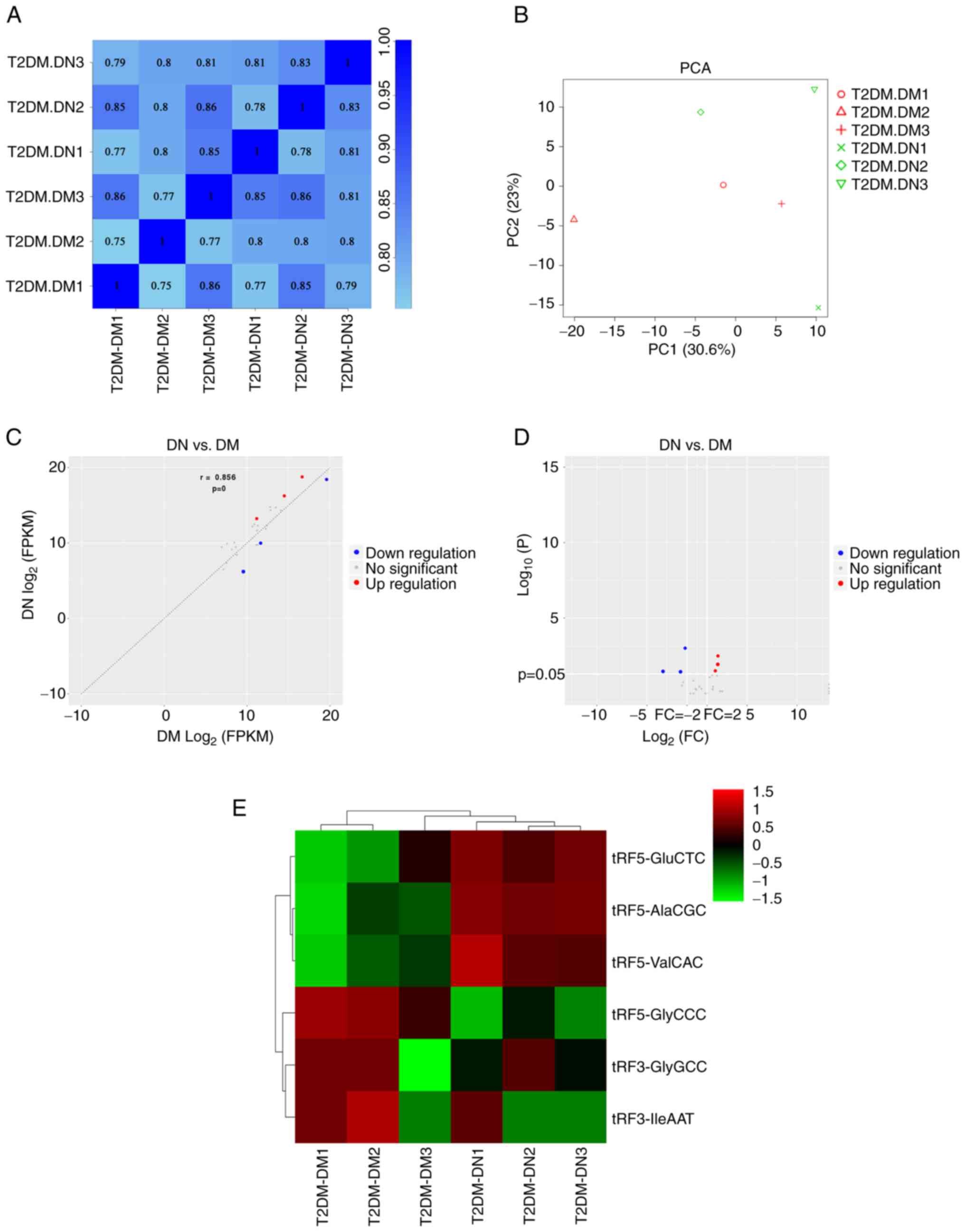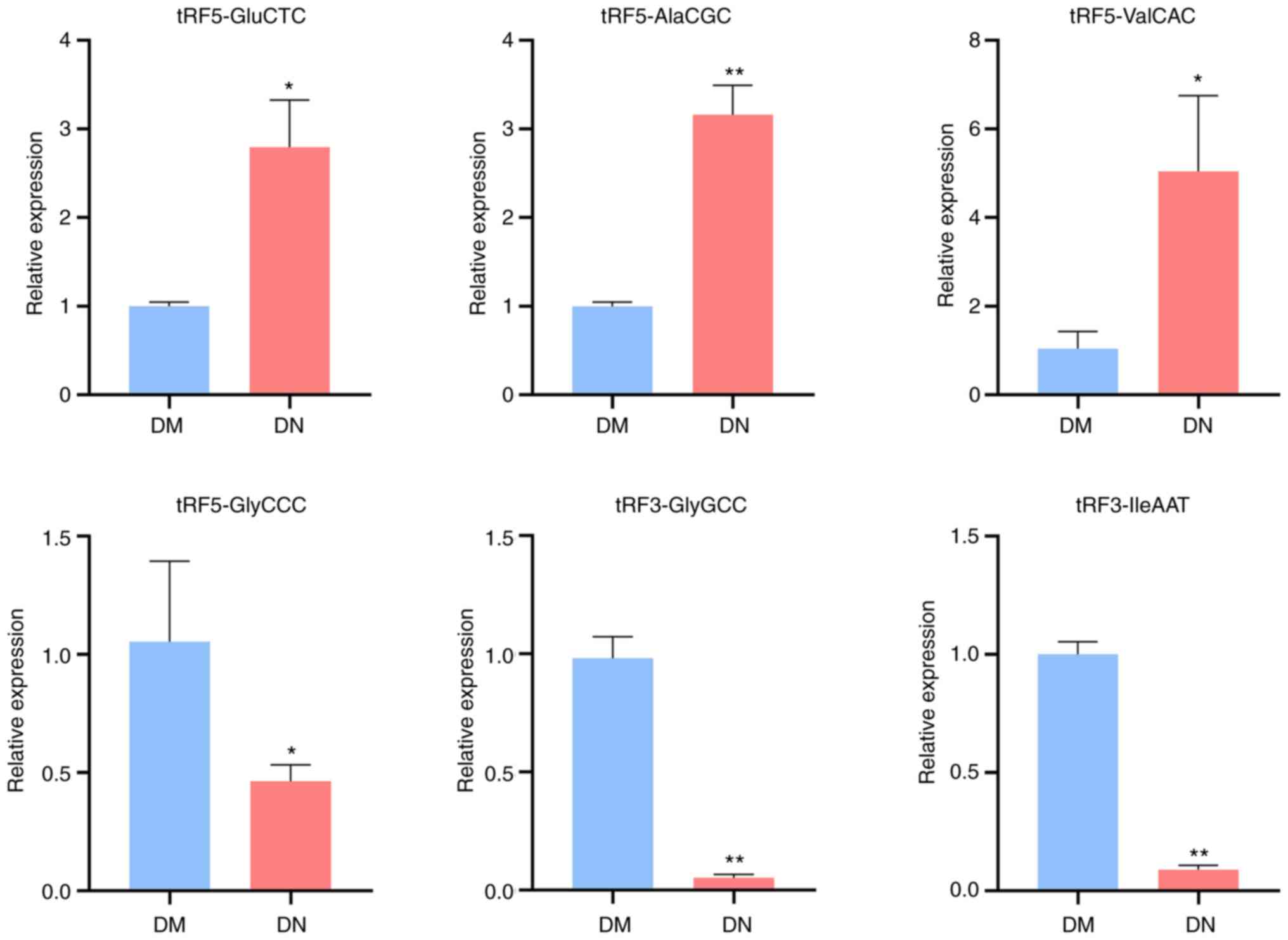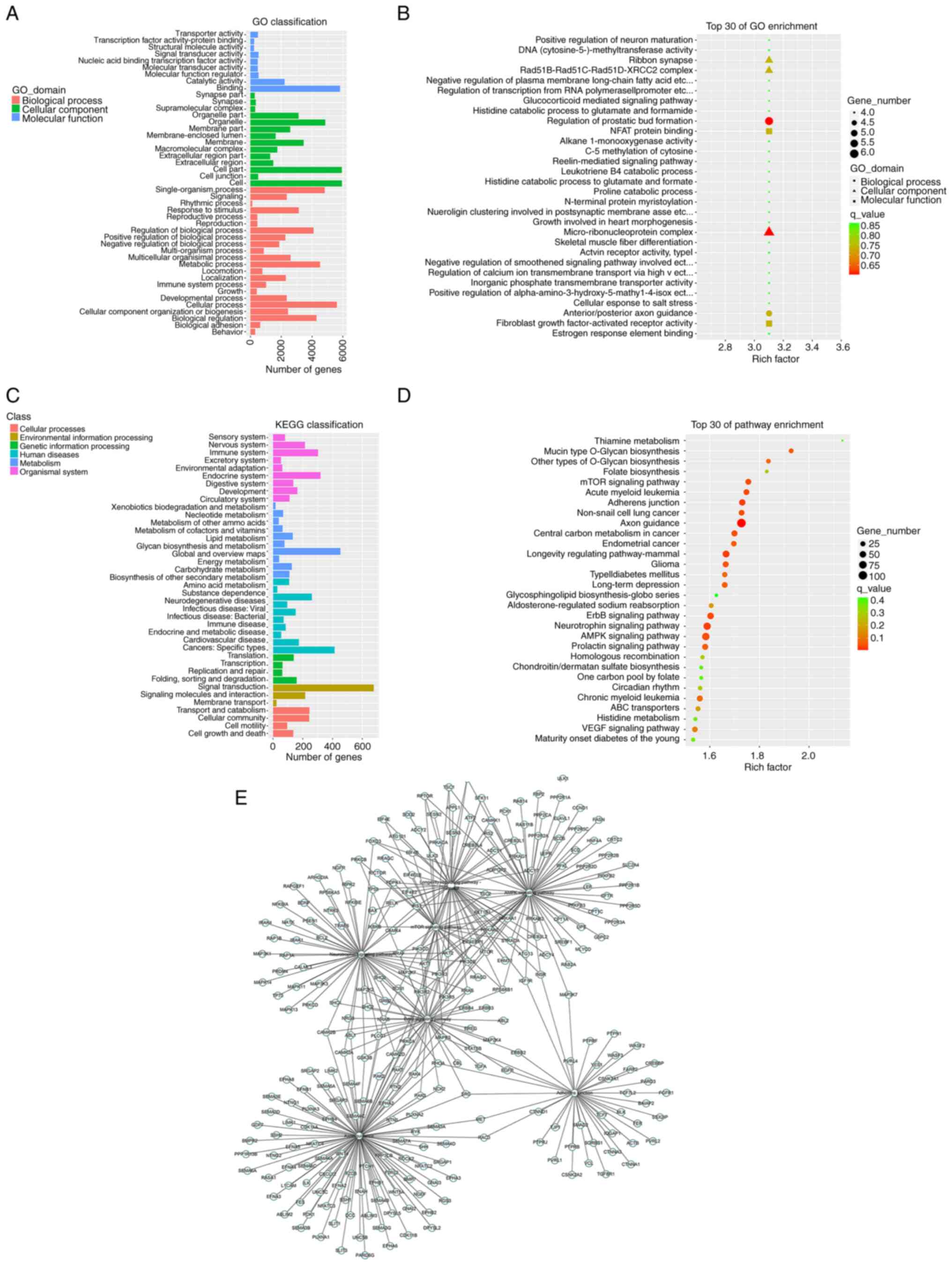|
1
|
Sagoo MK and Gnudi L: Diabetic
nephropathy: An overview. Methods Mol Biol. 2067:3–7.
2020.PubMed/NCBI View Article : Google Scholar
|
|
2
|
Umanath K and Lewis JB: Update on diabetic
nephropathy: Core curriculum 2018. Am J Kidney Dis. 71:884–895.
2018.PubMed/NCBI View Article : Google Scholar
|
|
3
|
Samsu N: Diabetic nephropathy: Challenges
in pathogenesis, diagnosis, and treatment. Biomed Res Int.
2021(1497449)2021.PubMed/NCBI View Article : Google Scholar
|
|
4
|
Krishna S, Raghavan S, DasGupta R and
Palakodeti D: tRNA-derived fragments (tRFs): Establishing their
turf in post-transcriptional gene regulation. Cell Mol Life Sci.
78:2607–2619. 2021.PubMed/NCBI View Article : Google Scholar
|
|
5
|
Zhu P, Yu J and Zhou P: Role of
tRNA-derived fragments in cancer: Novel diagnostic and therapeutic
targets tRFs in cancer. Am J Cancer Res. 10:393–402.
2020.PubMed/NCBI
|
|
6
|
Kumar P, Kuscu C and Dutta A: Biogenesis
and function of transfer RNA-related fragments (tRFs). Trends
Biochem Sci. 41:679–689. 2016.PubMed/NCBI View Article : Google Scholar
|
|
7
|
Winek K, Lobentanzer S, Nadorp B, Dubnov
S, Dames C, Jagdmann S, Moshitzky G, Hotter B, Meisel C, Greenberg
DS, et al: Transfer RNA fragments replace microRNA regulators of
the cholinergic poststroke immune blockade. Proc Natl Acad Sci USA.
117:32606–32616. 2020.PubMed/NCBI View Article : Google Scholar
|
|
8
|
Pandey KK, Madhry D, Ravi Kumar YS,
Malvankar S, Sapra L, Srivastava RK, Bhattacharyya S and Verma B:
Regulatory roles of tRNA-derived RNA fragments in human
pathophysiology. Mol Ther Nucleic Acids. 26:161–173.
2021.PubMed/NCBI View Article : Google Scholar
|
|
9
|
Panoutsopoulou K, Dreyer T, Dorn J,
Obermayr E, Mahner S, Gorp TV, Braicu I, Zeillinger R, Magdolen V,
Avgeris M and Scorilas A: tRNAGlyGCC-derived internal
fragment (i-tRF-GlyGCC) in ovarian cancer treatment outcome and
progression. Cancers (Basel). 14(24)2021.PubMed/NCBI View Article : Google Scholar
|
|
10
|
Yang W, Gao K, Qian Y, Huang Y, Xiang Q,
Chen C, Chen Q, Wang Y, Fang F, He Q, et al: A novel tRNA-derived
fragment AS-tDR-007333 promotes the malignancy of NSCLC via the
HSPB1/MED29 and ELK4/MED29 axes. J Hematol Oncol.
15(53)2022.PubMed/NCBI View Article : Google Scholar
|
|
11
|
Kwon NH, Lee JY and Kim S: Role of tRNAs
in breast cancer regulation. Adv Exp Med Biol. 1187:121–145.
2021.PubMed/NCBI View Article : Google Scholar
|
|
12
|
Cui H, Li H, Wu H, Du F, Xie X, Zeng S,
Zhang Z, Dong K, Shang L, Jing C and Li L: A novel 3'tRNA-derived
fragment tRF-Val promotes proliferation and inhibits apoptosis by
targeting EEF1A1 in gastric cancer. Cell Death Dis.
13(471)2022.PubMed/NCBI View Article : Google Scholar
|
|
13
|
Han Y, Peng Y, Liu S, Wang X, Cai C, Guo
C, Chen Y, Gao L, Huang Q, He M, et al: tRF3008A suppresses the
progression and metastasis of colorectal cancer by destabilizing
FOXK1 in an AGO-dependent manner. J Exp Clin Cancer Res.
41(32)2022.PubMed/NCBI View Article : Google Scholar
|
|
14
|
Huang Y, Ge H, Zheng M, Cui Y, Fu Z, Wu X,
Xia Y, Chen L, Wang Z, Wang S and Xie H: Serum tRNA-derived
fragments (tRFs) as potential candidates for diagnosis of nontriple
negative breast cancer. J Cell Physiol. 235:2809–2824.
2020.PubMed/NCBI View Article : Google Scholar
|
|
15
|
Shi H, Yu M, Wu Y, Cao Y, Li S, Qu G, Gong
J, Gan W and Zhang A: tRNA-derived fragments (tRFs) contribute to
podocyte differentiation. Biochem Biophys Res Commun. 521:1–8.
2020.PubMed/NCBI View Article : Google Scholar
|
|
16
|
Li S, Liu Y, He X, Luo X, Shi H, Qu G, Wen
X, Gan W, Wang J and Zhang A: tRNA-derived fragments in podocytes
with adriamycin-induced injury reveal the potential mechanism of
idiopathic nephrotic syndrome. Biomed Res Int.
2020(7826763)2020.PubMed/NCBI View Article : Google Scholar
|
|
17
|
Poel D, Buffart TE, Oosterling-Jansen J,
Verheul HM and Voortman J: Evaluation of several methodological
challenges in circulating miRNA qPCR studies in patients with head
and neck cancer. Exp Mol Med. 50(e454)2018.PubMed/NCBI View Article : Google Scholar
|
|
18
|
Livak KJ and Schmittgen TD: Analysis of
relative gene expression data using real-time quantitative PCR and
the 2(-Delta Delta C(T)) method. Methods. 25:402–408.
2001.PubMed/NCBI View Article : Google Scholar
|
|
19
|
Mengstie MA, Chekol Abebe E, Behaile
Teklemariam A, Tilahun Mulu A, Agidew MM, Teshome Azezew M, Zewde
EA and Agegnehu Teshome A: Endogenous advanced glycation end
products in the pathogenesis of chronic diabetic complications.
Front Mol Biosci. 9(1002710)2022.PubMed/NCBI View Article : Google Scholar
|
|
20
|
Rubin MF and Townsend RR: Aldosterone
blockade in diabetic nephropathy: Relative risks and potential
promise. J Am Soc Nephrol. 20:2487–2489. 2009.PubMed/NCBI View Article : Google Scholar
|
|
21
|
Winiarska A, Knysak M, Nabrdalik K,
Gumprecht J and Stompór T: Inflammation and oxidative stress in
diabetic kidney disease: Inflammation and oxidative stress in
diabetic kidney disease: The targets for SGLT2 inhibitors and GLP-1
receptor agonists. Int J Mol Sci. 22(10822)2021.PubMed/NCBI View Article : Google Scholar
|
|
22
|
Tosar JP and Cayota A: Extracellular tRNAs
and tRNA-derived fragments. RNA Biol. 17:1149–1167. 2020.PubMed/NCBI View Article : Google Scholar
|
|
23
|
Yu X, Xie Y, Zhang S, Song X, Xiao B and
Yan Z: tRNA-derived fragments: Mechanisms underlying their
regulation of gene expression and potential applications as
therapeutic targets in cancers and virus infections. Theranostics.
11:461–469. 2021.PubMed/NCBI View Article : Google Scholar
|
|
24
|
Lee YS, Shibata Y, Malhotra A and Dutta A:
A novel class of small RNAs: tRNA-derived RNA fragments (tRFs).
Genes Dev. 23:2639–2649. 2019.PubMed/NCBI View Article : Google Scholar
|
|
25
|
Goodarzi H, Liu X, Nguyen HC, Zhang S,
Fish L and Tavazoie SF: Endogenous tRNA-derived fragments suppress
breast cancer progression via YBX1 displacement. Cell. 161:790–802.
2015.PubMed/NCBI View Article : Google Scholar
|
|
26
|
Chen Q, Yan M, Cao Z, Li X, Zhang Y, Shi
J, Feng GH, Peng H, Zhang X, Zhang Y, et al: Sperm tsRNAs
contribute to intergenerational inheritance of an acquired
metabolic disorder. Science. 351:397–400. 2016.PubMed/NCBI View Article : Google Scholar
|
|
27
|
Fu Y, Lee I, Lee YS and Bao X: Small
non-coding transfer RNA-derived RNA fragments (tRFs): Their
biogenesis, function and implication in human diseases. Genomics
Inform. 13:94–101. 2015.PubMed/NCBI View Article : Google Scholar
|
|
28
|
Gupta T, Malkin MG and Huang S: tRNA
function and dysregulation in cancer. Front Cell Dev Biol.
10(886642)2022.PubMed/NCBI View Article : Google Scholar
|
|
29
|
Li D, Zhang H, Wu X, Dai Q, Tang S, Liu Y,
Yang S and Zhang W: Role of tRNA derived fragments in renal
ischemia-reperfusion injury. Ren Fail. 44:815–825. 2022.PubMed/NCBI View Article : Google Scholar
|
|
30
|
Deng J, Ptashkin RN, Chen Y, Cheng Z, Liu
G, Phan T, Deng X, Zhou J, Lee I, Lee YS and Bao X: Respiratory
syncytial virus utilizes a tRNA fragment to suppress antiviral
responses through a novel targeting mechanism. Mol Ther.
23:1622–1629. 2015.PubMed/NCBI View Article : Google Scholar
|
|
31
|
Tian H, Hu Z and Wang C: The therapeutic
potential of tRNA-derived small RNAs in neurodegenerative
disorders. Aging Dis. 13:389–401. 2022.PubMed/NCBI View Article : Google Scholar
|
|
32
|
Yu M, Lu B, Zhang J, Ding J, Liu P and Lu
Y: tRNA-derived RNA fragments in cancer: current status and future
perspectives. J Hematol Oncol. 13(121)2020.PubMed/NCBI View Article : Google Scholar
|
|
33
|
Nakanishi Y, Kang S and Kumanogoh A: Axon
guidance molecules in immunometabolic diseases. Inflamm Regen.
42(5)2022.PubMed/NCBI View Article : Google Scholar
|
|
34
|
Aggarwal PK, Veron D, Thomas DB, Siegel D,
Moeckel G, Kashgarian M and Tufro A: Semaphorin3a promotes advanced
diabetic nephropathy. Diabetes. 64:1743–1759. 2015.PubMed/NCBI View Article : Google Scholar
|
|
35
|
Jiao X, Zhang D, Hong Q, Yan L, Han Q,
Shao F, Cai G, Chen X and Zhu H: Netrin-1 works with UNC5B to
regulate angiogenesis in diabetic kidney disease. Front Med.
14:293–304. 2020.PubMed/NCBI View Article : Google Scholar
|
|
36
|
Zou YL, Luo WB, Xie L, Mao XB, Wu C and
You ZP: Targeting human 8-oxoguanine DNA glycosylase to
mitochondria protects cells from high glucose-induced apoptosis.
Endocrine. 60:445–457. 2018.PubMed/NCBI View Article : Google Scholar
|
|
37
|
Liu Y, Tarsounas M, O'Regan P and West SC:
Role of RAD51C and XRCC3 in genetic recombination and DNA repair. J
Biol Chem. 282:1973–1979. 2007.PubMed/NCBI View Article : Google Scholar
|
|
38
|
Macian F: NFAT proteins: Key regulators of
T-cell development and function. Nat Rev Immunol. 5:472–484.
2005.PubMed/NCBI View Article : Google Scholar
|
|
39
|
Nijenhuis T, Sloan AJ, Hoenderop JG,
Flesche J, van Goor H, Kistler AD, Bakker M, Bindels RJ, de Boer
RA, Möller CC, et al: Angiotensin II contributes to podocyte injury
by increasing TRPC6 expression via an NFAT-mediated positive
feedback signaling pathway. Am J Pathol. 179:1719–1732.
2011.PubMed/NCBI View Article : Google Scholar
|
|
40
|
Itoh N, Ohta H and Konishi M: Endocrine
FGFs: Evolution, physiology, pathophysiology, and pharmacotherapy.
Front Endocrinol (Lausanne). 6(154)2015.PubMed/NCBI View Article : Google Scholar
|
|
41
|
Zhang J and Li Y: . Therapeutic uses of
FGFs. Semin Cell Dev Biol. 53:144–154. 2016.PubMed/NCBI View Article : Google Scholar
|
|
42
|
Deng J, Liu Y, Liu Y, Li W and Nie X: The
multiple roles of fibroblast growth factor in diabetic nephropathy.
J Inflamm Res. 14:5273–5290. 2021.PubMed/NCBI View Article : Google Scholar
|
|
43
|
Skaper SD: Neurotrophic factors: An
overview. Methods Mol Biol. 1727:1–17. 2018.PubMed/NCBI View Article : Google Scholar
|
|
44
|
Zhao P, Li X, Li Y, Zhu J, Sun Y and Hong
J: Mechanism of miR-365 in regulating BDNF-TrkB signal axis of
HFD/STZ induced diabetic nephropathy fibrosis and renal function.
Int Urol Nephrol. 53:2177–2187. 2021.PubMed/NCBI View Article : Google Scholar
|
|
45
|
Ding Y and Choi ME: Autophagy in diabetic
nephropathy. J Endocrinol. 224:R15–R30. 2015.PubMed/NCBI View Article : Google Scholar
|
|
46
|
Tang G, Du Y, Guan H, Jia J, Zhu N, Shi Y,
Rong S and Yuan W: Butyrate ameliorates skeletal muscle atrophy in
diabetic nephropathy by enhancing gut barrier function and
FFA2-mediated PI3K/Akt/mTOR signals. Br J Pharmacol. 179:159–178.
2022.PubMed/NCBI View Article : Google Scholar
|
|
47
|
Li A, Yi B, Han H, Yang S, Hu Z, Zheng L,
Wang J, Liao Q and Zhang H: Vitamin D-VDR (vitamin D receptor)
regulates defective autophagy in renal tubular epithelial cell in
streptozotocin-induced diabetic mice via the AMPK pathway.
Autophagy. 18:877–890. 2022.PubMed/NCBI View Article : Google Scholar
|

















